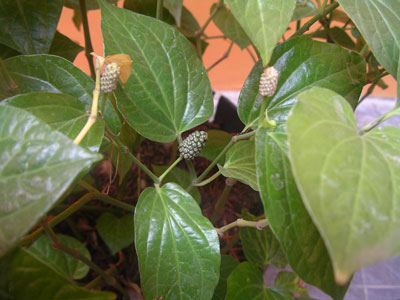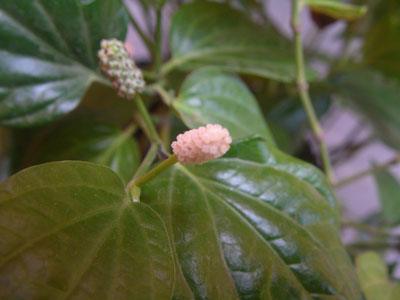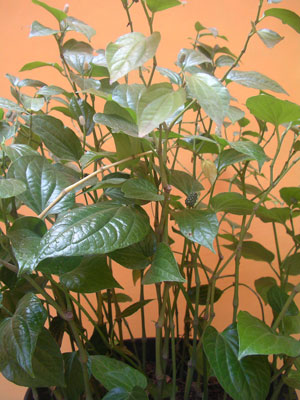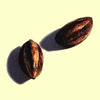Piper sarmentosum (Indonesian: Karuk)
There is no common English name for this leaf, though it is sometimes mistakenly referred to as "betel leaf" or "wild betel leaf". They are sold in bunches, still on the stems, at Asian shops where they are called by their Thai name, cha plu, or the Vietnamese name, bo la lot. Though of the same family (Piperaceae) as the betel leaf, karuk is a finer, tender leaf, brighter green and with distinct veins. It is more delicate in flavour than betel leaf though still slightly pungent, and is eaten raw in Thai cuisine, especially as a leafy wrapping for snacks and appetisers called miang.
Sixteen compounds were isolated from the fresh roots of Piper sarmentosum. Seven of these have been isolated from the fruits and leaves of this plant: the aromatic alkene (1), 1-allyl-2-methoxy-4,5-methylenedioxybenzene (4), beta-sitosterol, pyrrole amide (6), sarmentine (10), sarmentosine (13) and pellitorine (14). (+)-Sesamin (2), horsfieldin (3), two pyrrolidine amides 11 and 12, guineensine (15) and brachystamide B (16).
K. Heyne in his book 'De Nuttige Planten van Indonesie" describes the use of karuk leaves to cure asthma, i.e. by rubbing crushed leaves around the neck. The most important active compound in this respect is the pyrrole amide, which acts by promoting expectoration. Chinese Medicinal Herb of Taiwan also mentioned Piper sarmentosum as a medicinal plant with warming, anti-swelling and anaesthetic properties.
In Indonesia, a decoction of the boiled leaves has been known to be effective in treating malaria, asthma, coughs, flu, rheumatism, pleurisy and lumbago. The root is a remedy for toothache and may be made into a wash for fungoid dermatitis on the feet. The leaves are also reported to contain antioxidant property.
In Laos it is used in salad. In Malaysia (where they are called daun kadok) the leaves are shredded for ulam (a mixture of fresh herbs). In one of the top hotels in Kuala Lumpur, the chef used the leaves in a recipe which was not traditional: a cross-culture creation midway between a fish terrine and the local Nonya otak-otak, a highly spiced fish paste. It was formed in a triangular mould lined with daun kadok leaves, turned out on a serving dish, then cut in elegant triangular slices.
Otak-otak is usually pressed between coconut leaves or strips of banana leaves and grilled over coals, often at roadside stalls. The coconut or banana leaf wrapper is stripped away and discarded after the layer of fish is eaten. In the hotel presentation, the soft P. sarmentosum leaf, no thicker than spinach, was eaten with the fish.
Purchasing and storing: Choose bright green, uncrushed leaves which are not faded or limp. Leaves can be kept wrapped loosely in damp paper and refrigerated for a day or two. If leaves need reviving, try soaking for 2 or 3 hours in cold water to which a spoonful of sugar has been added. This also sweetens the flavour of the leaves.
Recipe: Leaf-Wrapped Snacks
1 bunch karuk leaves
Fillings
200 g/7 oz shredded cooked pork, or chicken, or small shelled prawns
90 g/3 oz/1/2 cup roasted, salted peanuts
60 g/2 oz/1/2 cup sliced shallots
sliced chillies
3 tablespoons sliced pickled radish (optional)
Sauce
1 tablespoon palm sugar
1 tablespoon lime juice
1 tablespoon tamarind purée
2 tablespoons fish sauce
2 tablespoons dried shrimp floss (optional)
1/2 teaspoon crushed garlic
Wash the leaves well and soak in cold, lightly sugared water for a couple of hours. Pat leaves dry. Prepare the fillings and arrange around a platter, with the leaves. Mix sauce ingredients in a small bowl. Each person puts their choice of fillings on a leaf, wraps it and dips the leaf in the sauce before eating.
Note: For special occasions, the leaf snacks may be presented already wrapped, and luxury ingredients such as crab meat included in the filling. The leaf parcel is secured with a cocktail stick.
Other Languages:
Indonesia: karuk, sirih tanah
Chinese : jia ju, xi ye qing wei teng, qing ju
Laos: phak i leut
Malaysia: daun kadok
Thailand: cha plu
Vietnam: bo la lot



References:
Chemical constituents of the roots of Piper sarmentosum
Chemical constituents and bioactivity of Piper sarmentosum
Natural antioxidants: Piper sarmentosum and Morinda elliptica
Adulticidal activity against Stegomyia aegypti (Diptera: Culicidae) of three Piper spp.
Hypoglycemic effect of the water extract of Piper sarmentosum in rats.


1 Comment
Recommended Comments
Create an account or sign in to comment
You need to be a member in order to leave a comment
Create an account
Sign up for a new account in our community. It's easy!
Register a new accountSign in
Already have an account? Sign in here.
Sign In Now